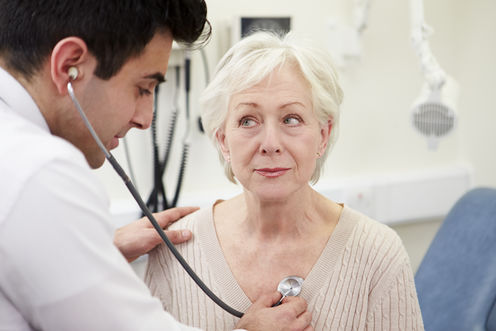
The problem of questionable treatment and tests which may provide little or no benefit, yet may cause harm, is ubiquitous across all areas of health care.
Harm doesn’t just come in the form of side-effects or further testing. The “cons” of any treatment or test also include the costs, which can be financial, emotional, and the costs of the individual’s time.
The Choosing Wisely campaign encourages patients and clinicians to question unnecessary treatments. First launched in America in 2012 and in Australia last year, the clinician-led initiative collates lists of tests, treatments and procedures that provide little or no value, and which may cause harm.
Today the Australian organisers, NPS MedicineWise, will release an additional 61 recommendations. These include:
-
Don’t order chest x-rays in patients with uncomplicated acute bronchitis (Routine chest x-rays don’t improve outcomes and may lead to false positives, further investigations and unnecessary radiation)
-
Avoid prescribing antibiotics for upper respiratory tract infections, also known as the common cold (Most uncomplicated upper respiratory infections are viral and antibiotic therapy isn’t suitable)
-
Don’t initiate medicines to prevent disease in patients who have a limited life expectancy (There is limited evidence to support the use of many medicines in frail, elderly patients who are more susceptible to the side-effects of medicines)
-
Don’t routinely do a pelvic examination with a pap smear (The procedure can cause pain, fear, anxiety and embarrassment and can lead to unnecessary, invasive and potentially harmful diagnostic procedures)
-
Don’t request imaging for patients with non-specific low back pain (Trials have consistently shown there is no advantage from routine imaging of non-specific low back pain and there are potential harms).
The need for informed conversations about potentially unnecessary treatments, tests and procedures is certainly not restricted to only the medical professions.
As well as the medical colleges and societies involved, it is encouraging that in this second release, organisations which represent nurses and allied health professionals such as physiotherapists and hospital pharmacists have participated. Hopefully in future releases, we will see more of Australia’s allied health organisations becoming involved in Choosing Wisely.
As with the 2015 lists, most of the recommendations are about doing less. Only a few are about encouraging a particular action to be done. An example is having an earlier conversation about prognosis, wishes, values and end of life in patients with advanced disease.
This may be because we clinicians are guilty more often of doing too much than too little.
This is counter-intuitive to most of us. Somehow, the thought that a clinician might have not done enough feels more reprehensible than their having done too much. And this is not just what patients might think – it’s probably true of many clinicians as well.
The memories of many junior hospital doctors probably include over-ordering tests (“just in case”, but also to demonstrate their knowledge of rare diagnostic possibilities) to avoid their seniors criticising them during an upcoming ward round.
The realisation that patients can actually be harmed more by receiving unnecessary tests, procedures, and treatments, than by not having received them has been painfully slow.
The Choosing Wisely campaign helps to signal a very important departure from normal business for clinicians and their organisations – thinking about not doing things.
While one of the drivers behind the Choosing Wisely campaign is reducing the tests and treatments people receive that provide little or no benefit, another is minimising the harm that can result from them.
For many of the recommendations, the harm is one that affects the individual. Quite a few of the recommendations are about not doing medical imaging and screening (such as not requesting imaging for non-specific low back pain). These typify individual harm – for example, unnecessary radiation exposure increases the risk of cancer.
Then there is a cluster of recommendations about the wise use of antibiotics. Antibiotic use has the interesting peculiarity of potentially causing harm to both individual patients and the community. We know that antibiotics – which can be life-saving for some serious infections such as meningitis and pneumonia – have little benefits to the common coughs and colds that make up a huge proportion of general practitioner visits. On balance, these benefits are of the same order as the common harms they cause (such as vaginal or oral thrush, diarrhoea, rashes, and so on).
But another important harm is the risk of inducing resistance. Antibiotic resistance – when bacteria adapt and antibiotics fail – is a deepening crisis that is already killing thousands directly and may soon disrupt many routine clinical procedures.
Antibiotic resistance is a direct result of antibiotic use. The more antibiotics are used when they are not needed, the less likely they are to be effective when needed for a bacterial infection.
So while the unnecessary use of antibiotics has potential harms to the individual, it can also contribute to the restricted use of antibiotics by others in the community who do need it.
For all of the recommendations, there is the harm to society that occurs from the wasted resources and cost of providing unnecessary tests and treatments, often at the expense of more effective uses of precious health care dollars.
But the premise behind Choosing Wisely is not about cost-cutting. It is one of the few existing processes for dealing with the one-way ratchet caused by more treatments and tests being generated every year, all of which increases the amount of things that can – but not necessarily should – be provided to patients.
No test or treatment should be provided to a patient without a conversation between the patient and clinician, during which the options (including the option of doing nothing), their benefits and harms, and the patient’s preferences and values are discussed.
Tammy Hoffmann has received funding from the NHMRC and ACSQHC for research about shared decision making.
Chris Del Mar receives funding from the NHMRC and ACSQHC for related research
